Hoffman D.M., Singh B., Thomas J.H. (Eds). Handbook of Vacuum Science and Technology
Подождите немного. Документ загружается.

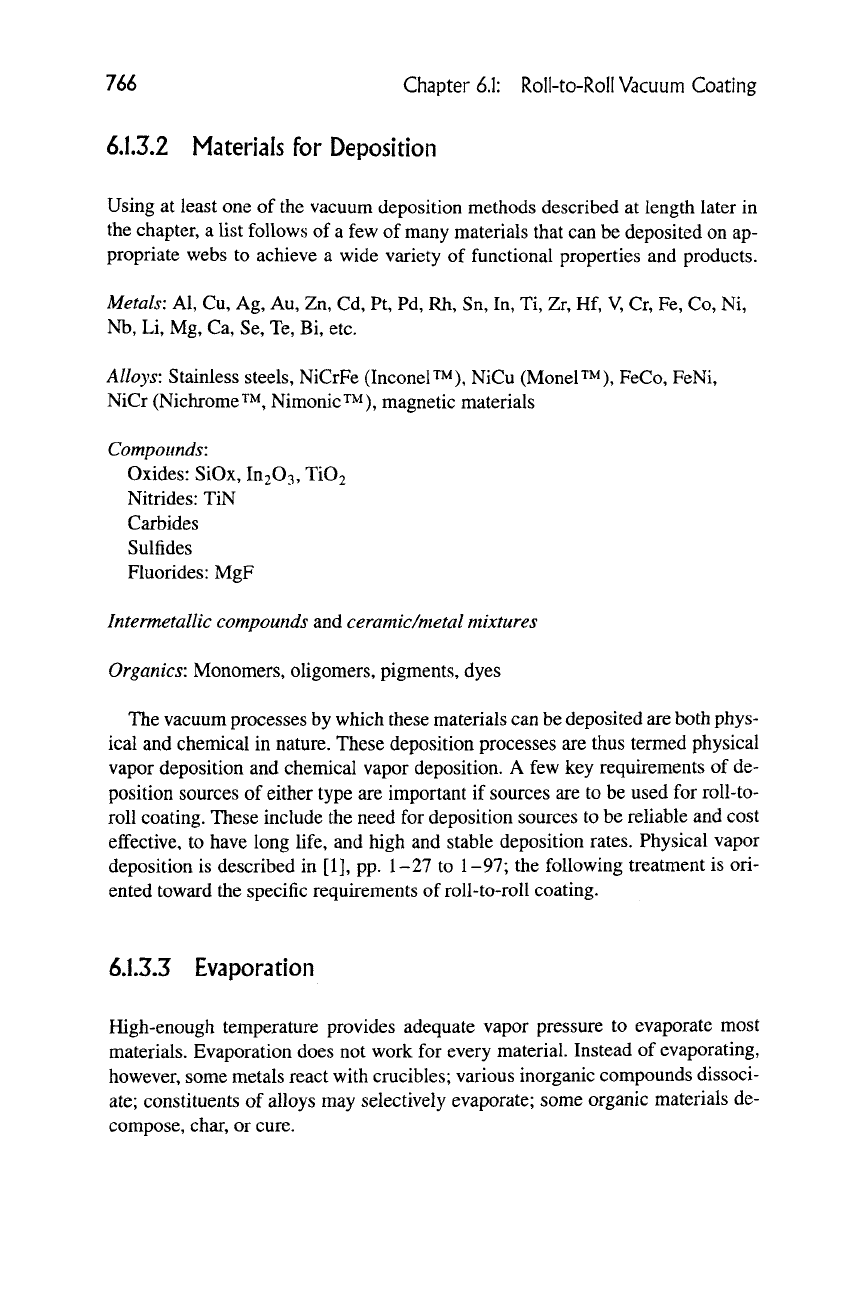
7(>f>
Chapter
6.1:
RoII-to-RolI
Vacuum
Coating
6.1.3.2
Materials for Deposition
Using at least one of the vacuum deposition methods described at length later in
the chapter, a list follows of a few of many materials that can be deposited on ap-
propriate webs to achieve a wide variety of functional properties and products.
Metals: Al, Cu, Ag, Au, Zn, Cd, Pt, Pd, Rh, Sn, In, Ti, Zr, Hf, V, Cr, Fe, Co, Ni,
Nb,
Li, Mg, Ca, Se, Te, Bi, etc.
Alloys: Stainless steels, NiCrFe (InconeFM), NiCu (MoneFM), PeCo, FeNi,
NiCr (Nichrome^M^ NimonicT^), magnetic materials
Compounds:
Oxides: SiOx,
In203,
Ti02
Nitrides: TiN
Carbides
Sulfides
Fluorides: MgF
Intermetallic compounds and ceramic/metal mixtures
Organics: Monomers, oligomers, pigments, dyes
The vacuum processes by which these materials can be deposited are both phys-
ical and chemical in nature. These deposition processes are thus termed physical
vapor deposition and chemical vapor deposition. A few key requirements of de-
position sources of either type are important if sources are to be used for roll-to-
roll coating. These include the need for deposition sources to be reliable and cost
effective, to have long life, and high and stable deposition rates. Physical vapor
deposition is described in [1], pp. 1-27 to 1-97; the following treatment is ori-
ented toward the specific requirements of roll-to-roll coating.
6.1.3.3
Evaporation
High-enough temperature provides adequate vapor pressure to evaporate most
materials. Evaporation does not work for every material. Instead of evaporating,
however, some metals react with crucibles; various inorganic compounds dissoci-
ate;
constituents of alloys may selectively evaporate; some organic materials de-
compose, char, or cure.
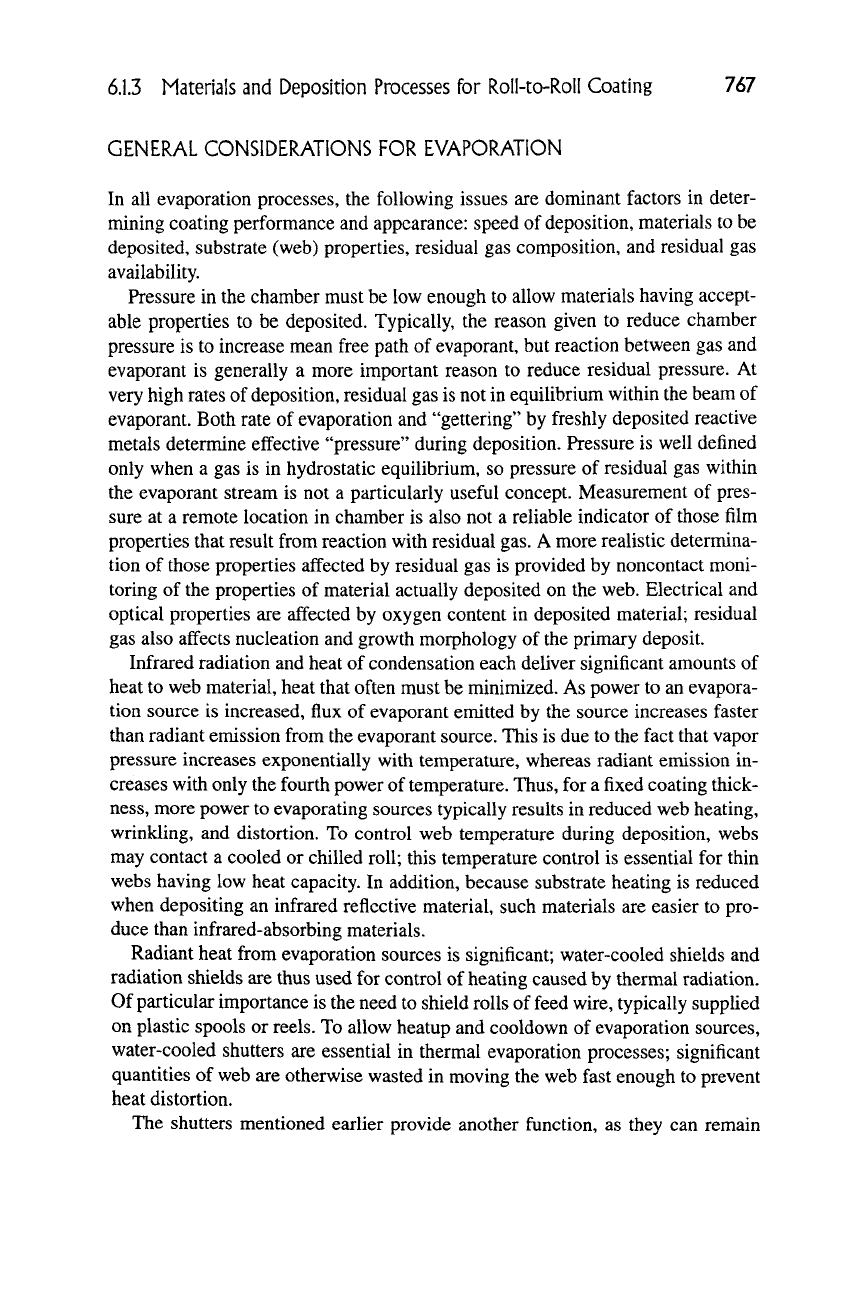
6.1.3 Materials and Deposition Processes for Roll-to-Roll Coating 767
GENERAL CONSIDERATIONS FOR EVAPORATION
In all evaporation processes, the following issues are dominant factors in deter-
mining coating performance and appearance: speed of deposition, materials to be
deposited, substrate (web) properties, residual gas composition, and residual gas
availability.
Pressure in the chamber must be low enough to allow materials having accept-
able properties to be deposited. Typically, the reason given to reduce chamber
pressure is to increase mean free path of evaporant, but reaction between gas and
evaporant is generally a more important reason to reduce residual pressure. At
very high rates of deposition, residual gas is not in equilibrium within the beam of
evaporant. Both rate of evaporation and "gettering" by freshly deposited reactive
metals determine effective "pressure" during deposition. Pressure is well defined
only when a gas is in hydrostatic equilibrium, so pressure of residual gas within
the evaporant stream is not a particularly useful concept. Measurement of pres-
sure at a remote location in chamber is also not a reliable indicator of those film
properties that result from reaction with residual gas. A more realistic determina-
tion of those properties affected by residual gas is provided by noncontact moni-
toring of the properties of material actually deposited on the web. Electrical and
optical properties are affected by oxygen content in deposited material; residual
gas also affects nucleation and growth morphology of the primary deposit.
Infrared radiation and heat of condensation each deliver significant amounts of
heat to web material, heat that often must be minimized. As power to an evapora-
tion source is increased, flux of evaporant emitted by the source increases faster
than radiant emission from the evaporant source. This is due to the fact that vapor
pressure increases exponentially with temperature, whereas radiant emission in-
creases with only the fourth power of temperature. Thus, for a fixed coating thick-
ness,
more power to evaporating sources typically results in reduced web heating,
wrinkling, and distortion. To control web temperature during deposition, webs
may contact a cooled or chilled roll; this temperature control is essential for thin
webs having low heat capacity. In addition, because substrate heating is reduced
when depositing an infrared reflective material, such materials are easier to pro-
duce than infrared-absorbing materials.
Radiant heat from evaporation sources is significant; water-cooled shields and
radiation shields are thus used for control of heating caused by thermal radiation.
Of particular importance is the need to shield rolls of feed wire, typically supplied
on plastic spools or reels. To allow heatup and cooldown of evaporation sources,
water-cooled shutters are essential in thermal evaporation processes; significant
quantities of web are otherwise wasted in moving the web fast enough to prevent
heat distortion.
The shutters mentioned earlier provide another function, as they can remain
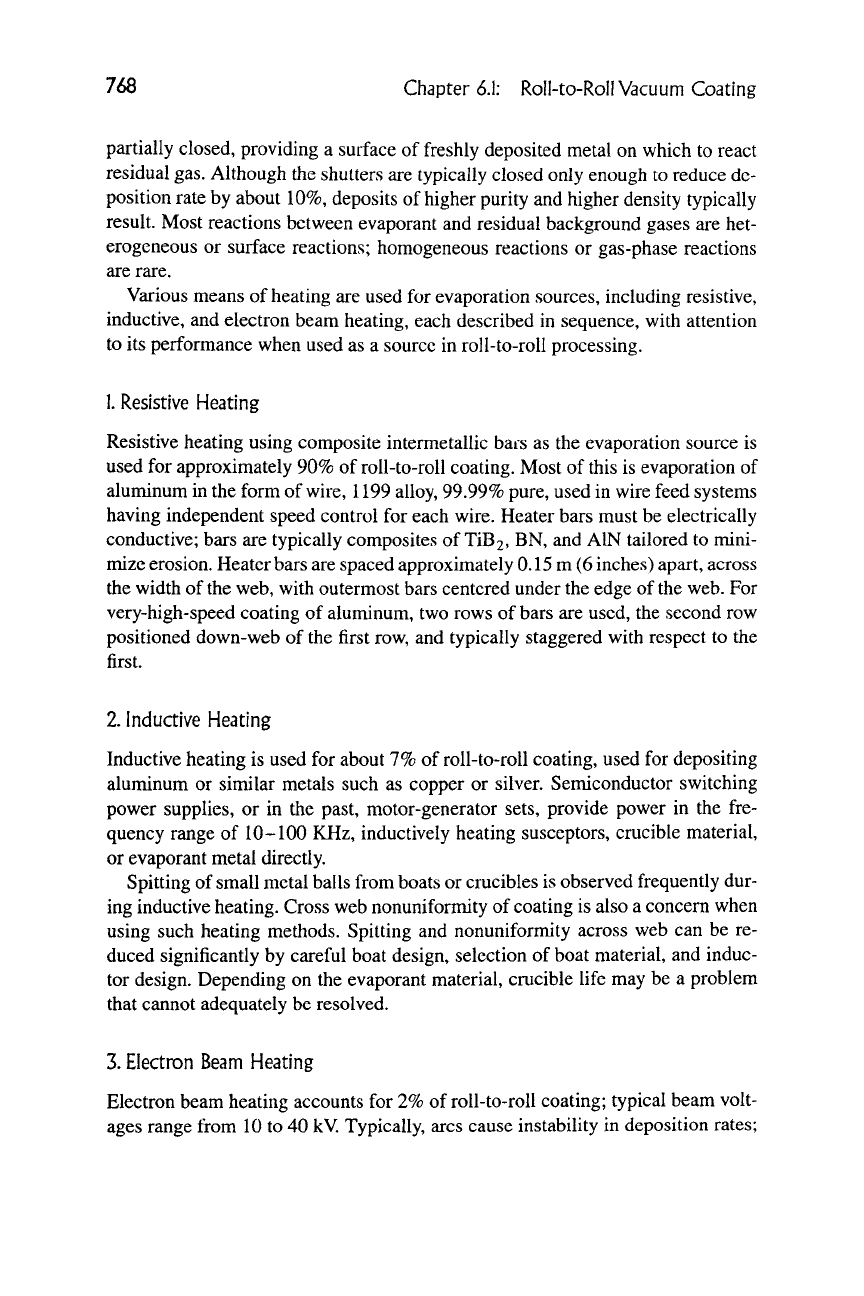
768 Chapter
6.1:
Roll-to-Roll
Vacuum
Coating
partially closed, providing a surface of freshly deposited metal on which to react
residual gas. Although the shutters aie typically closed only enough to reduce de-
position rate by about 10%, deposits of higher purity and higher density typically
result. Most reactions between evaporant and residual background gases are het-
erogeneous or surface reactions; homogeneous reactions or gas-phase reactions
are rare.
Various means of heating are used for evaporation sources, including resistive,
inductive, and electron beam heating, each described in sequence, with attention
to its performance when used as a source in roll-to-roll processing.
1.
Resistive Heating
Resistive heating using composite intermetallic bars as the evaporation source is
used for approximately 90% of roll-to-roll coating. Most of this is evaporation of
aluminum in the form of
wire,
1199 alloy, 99.99% pure, used in wire feed systems
having independent speed control for each wire. Heater bars must be electrically
conductive; bars are typically composites of
TiB2,
BN, and AIN tailored to mini-
mize erosion. Heater bars are spaced approximately 0.15 m (6 inches) apart, across
the width of the web, with outermost bars centered under the edge of the web. For
very-high-speed coating of aluminum, two rows of bars are used, the second row
positioned down-web of the first row, and typically staggered with respect to the
first.
2.
Inductive Heating
Inductive heating is used for about 7% of roll-to-roll coating, used for depositing
aluminum or similar metals such as copper or silver. Semiconductor switching
power supplies, or in the past, motor-generator sets, provide power in the fre-
quency range of 10-100 KHz, inductively heating susceptors, crucible material,
or evaporant metal directly.
Spitting of small metal balls from boats or crucibles is observed frequently dur-
ing inductive heating. Cross web nonuniformity of coating is also a concern when
using such heating methods. Spitting and nonuniformity across web can be re-
duced significantly by careful boat design, selection of boat material, and induc-
tor design. Depending on the evaporant material, crucible life may be a problem
that cannot adequately be resolved.
3. Electron Beam Heating
Electron beam heating accounts for 2% of roll-to-roll coating; typical beam volt-
ages range from 10 to 40 kV Typically, arcs cause instability in deposition rates;

6.1.3 Materials and Deposition Processes for Roll-to-RolI Coating 769
arcs result when pressure is too high or when feedthroughs and insulators become
contaminated, especially by magnetic materials. Arcs may be minimized by using
electron beam guns that arc differentially pumped, reducing pressure inside guns
and contamination of guns. An indirectly heated electron emitter improves fila-
ment life. Power supply reliability is also a recurrent difficulty for many electron
beam systems.
Rods fed through the bottom of the crucible, or wire fed into the melted pool of
material permit much longer deposition runs than would be permitted by inven-
tory of materials in boat or crucible at the beginning of run. Such techniques are
particularly important when trying to control composition of evaporated alloy, by
helping to stabilize level of melt.
Control of alloy composition is easily realized when an alloy evaporates con-
gruently. Congruent evaporation is analogous to an azeotrope, providing a fixed
composition on evaporation; NiFe (15%) (Permalloy) is a good example, as is
CrGe. Materials that closely approximate the composition of a congruent evapo-
rant can be deposited by focusing an e-beam to a small spot on a stable level of
melt. This small spot is highly heated, and diffusion in the melt limits the avail-
ability of the higher-vapor-pressure component. Use of rod feed or wire feed as
described may provide requisite melt level control. An example of material de-
posited using this procedure is NiCr (17%) Nichrome^^^
CRUCIBLE AND BOAT MATERIALS
The materials from which crucibles or liners are made often significantly limit the
evaporation process, as some molten metals attack almost any material. Molten
aluminum exhibits this problem, dissolving most materials that it contacts. Mate-
rials have been developed for crucibles and bars for wire feed heating diat are
quite adequate for evaporation of aluminum. Given the time and expense to re-
place wire feed bars or crucibles, replacement becomes largely an economic is-
sue;
operational performance isn't severely affected. A few evaporant materials
have no appropriate crucible or bar material to meet demands for long life, reli-
ability, low cost, and minimal contamination typically demanded by roll-to-roll
coating. Evaporation in small laboratory operations is not an adequate indicator
of bar or crucible performance in typical industrial roll-to-roll operations.
Some of the limitations just discussed that are produced by available crucible
materials are relaxed in the e-beam process for the following three reasons:
1.
Typically, crucibles sit in a copper hearth that is water cooled. The tempera-
ture at the interface between melt and crucible is significantly cooler than the tem-
perature of that same interface in a resistively heated system. In a resistively
heated system, all necessary power is provided through that interface, whereas
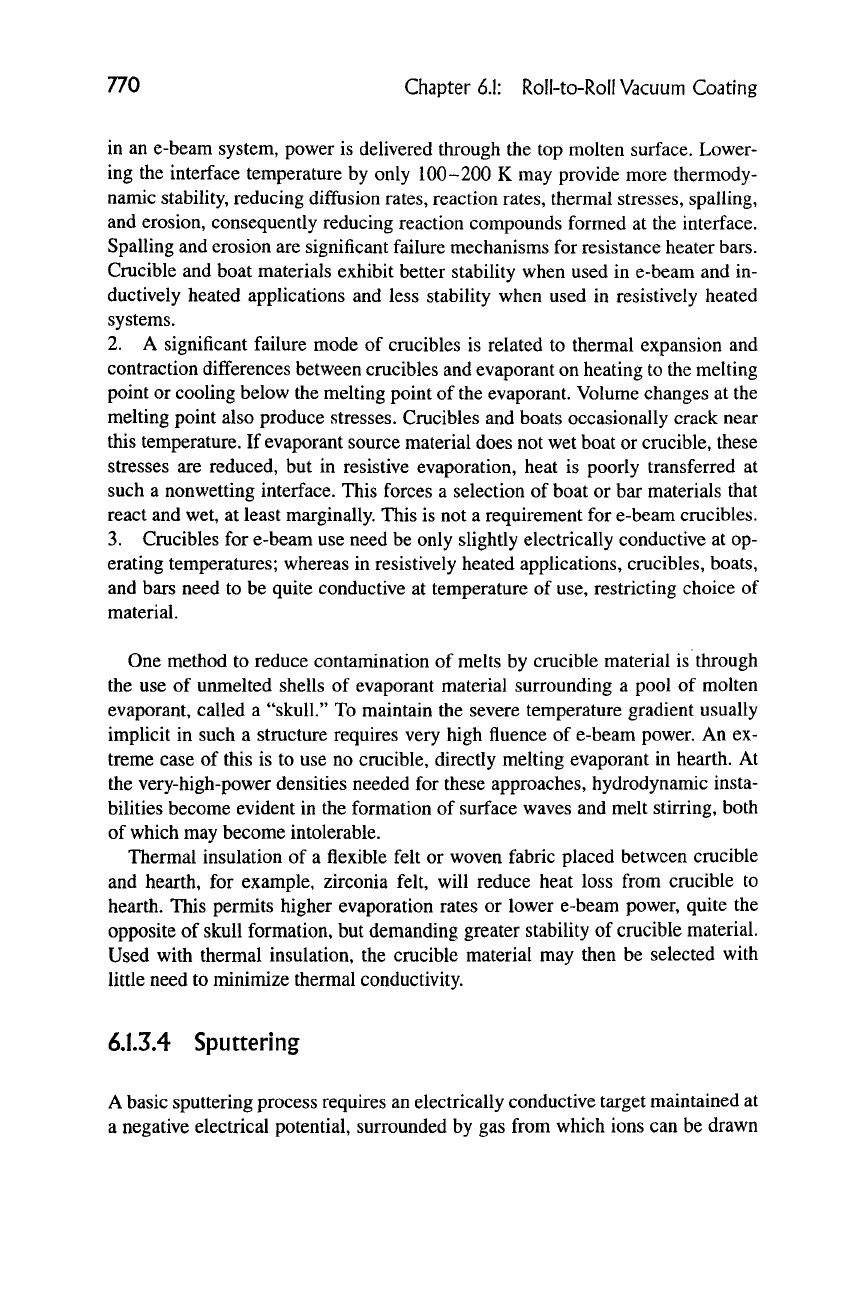
770 Chapter
6.1:
Roll-to-RoIl
Vacuum
Coating
in an e-beam system, power is delivered through the top molten surface. Lower-
ing the interface temperature by only 100-200 K may provide more thermody-
namic stability, reducing diffusion rates, reaction rates, thermal stresses, spalling,
and erosion, consequently reducing reaction compounds formed at the interface.
Spalling and erosion are significant failure mechanisms for resistance heater bars.
Crucible and boat materials exhibit better stability when used in e-beam and in-
ductively heated applications and less stability when used in resistively heated
systems.
2.
A significant failure mode of crucibles is related to thermal expansion and
contraction differences between crucibles and evaporant on heating to the melting
point or cooling below the melting point of the evaporant. Volume changes at the
melting point also produce stresses. Crucibles and boats occasionally crack near
this temperature. If evaporant source material does not wet boat or crucible, these
stresses are reduced, but in resistive evaporation, heat is poorly transferred at
such a nonwetting interface. This forces a selection of boat or bar materials that
react and wet, at least marginally. This is not a requirement for e-beam crucibles.
3.
Crucibles for e-beam use need be only slightly electrically conductive at op-
erating temperatures; whereas in resistively heated applications, crucibles, boats,
and bars need to be quite conductive at temperature of use, restricting choice of
material.
One method to reduce contamination of melts by crucible material is through
the use of unmelted shells of evaporant material surrounding a pool of molten
evaporant, called a "skull." To maintain the severe temperature gradient usually
implicit in such a structure requires very high fluence of e-beam power. An ex-
treme case of this is to use no crucible, directly melting evaporant in hearth. At
the very-high-power densities needed for these approaches, hydrodynamic insta-
bilities become evident in the formation of surface waves and melt stirring, both
of which may become intolerable.
Thermal insulation of a flexible felt or woven fabric placed between crucible
and hearth, for example, zirconia felt, will reduce heat loss from crucible to
hearth. This permits higher evaporation rates or lower e-beam power, quite the
opposite of skull formation, but demanding greater stability of crucible material.
Used with thermal insulation, the crucible material may then be selected with
little need to minimize thermal conductivity.
6.1.3.4 Sputtering
A basic sputtering process requires an electrically conductive target maintained at
a negative electrical potential, surrounded by gas from which ions can be drawn
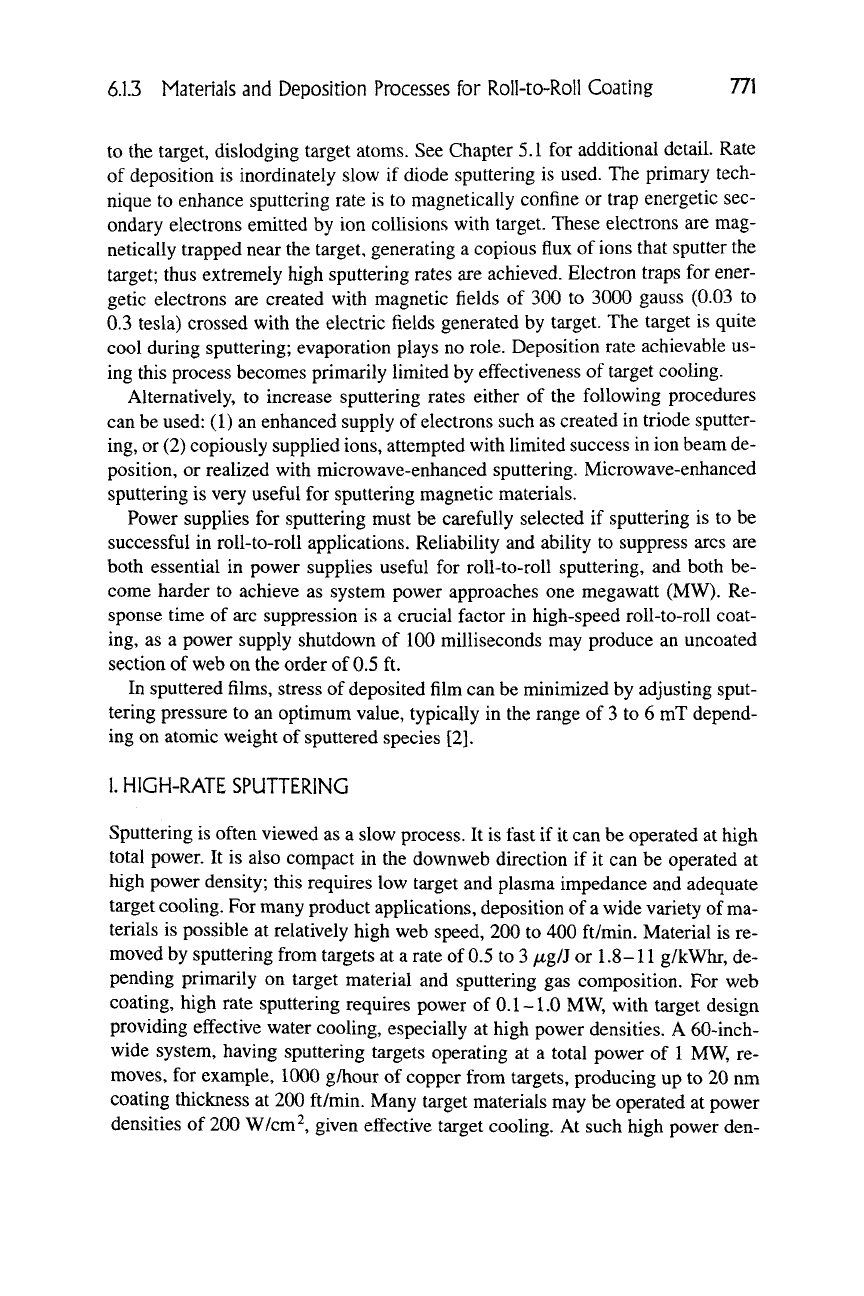
6.1.3 Materials and Deposition Processes for Roll-to-RoIl Coating 771
to the target, dislodging target atoms. See Chapter 5.1 for additional detail. Rate
of deposition is inordinately slow if diode sputtering is used. The primary tech-
nique to enhance sputtering rate is to magnetically confine or trap energetic sec-
ondary electrons emitted by ion collisions with target. These electrons are mag-
netically trapped near the target, generating a copious flux of ions that sputter the
target; thus extremely high sputtering rates are achieved. Electron traps for ener-
getic electrons are created with magnetic fields of 300 to 3000 gauss (0.03 to
0.3 tesla) crossed with the electric fields generated by target. The target is quite
cool during sputtering; evaporation plays no role. Deposition rate achievable us-
ing this process becomes primarily limited by effectiveness of target cooling.
Alternatively, to increase sputtering rates either of the following procedures
can be used: (1) an enhanced supply of electrons such as created in triode sputter-
ing, or (2) copiously supplied ions, attempted with limited success in ion beam de-
position, or realized with microwave-enhanced sputtering. Microwave-enhanced
sputtering is very useful for sputtering magnetic materials.
Power supplies for sputtering must be carefully selected if sputtering is to be
successful in roll-to-roll applications. Reliability and ability to suppress arcs are
both essential in power supplies useful for roll-to-roll sputtering, and both be-
come harder to achieve as system power approaches one megawatt (MW). Re-
sponse time of arc suppression is a crucial factor in high-speed roll-to-roll coat-
ing, as a power supply shutdown of 100 milliseconds may produce an uncoated
section of web on the order of 0.5 ft.
In sputtered films, stress of deposited film can be minimized by adjusting sput-
tering pressure to an optimum value, typically in the range of 3 to 6 mT depend-
ing on atomic weight of sputtered species [2].
1.
HIGH-RATE SPUTTERING
Sputtering is often viewed as a slow process. It is fast if it can be operated at high
total power. It is also compact in the downweb direction if it can be operated at
high power density; this requires low target and plasma impedance and adequate
target cooling. For many product applications, deposition of
a
wide variety of ma-
terials is possible at relatively high web speed, 200 to 400 ft/min. Material is re-
moved by sputtering from targets at a rate of 0.5 to 3 /xg/J or
1.8-11
g/kWhr, de-
pending primarily on target material and sputtering gas composition. For web
coating, high rate sputtering requires power of 0.1-1.0 MW, with target design
providing effective water cooling, especially at high power densities. A 60-inch-
wide system, having sputtering targets operating at a total power of 1 MW, re-
moves, for example, 1000 g/hour of copper from targets, producing up to 20 nm
coating thickness at 200 ft/min. Many target materials may be operated at power
densities of 200 W/cm^, given effective target cooling. At such high power den-
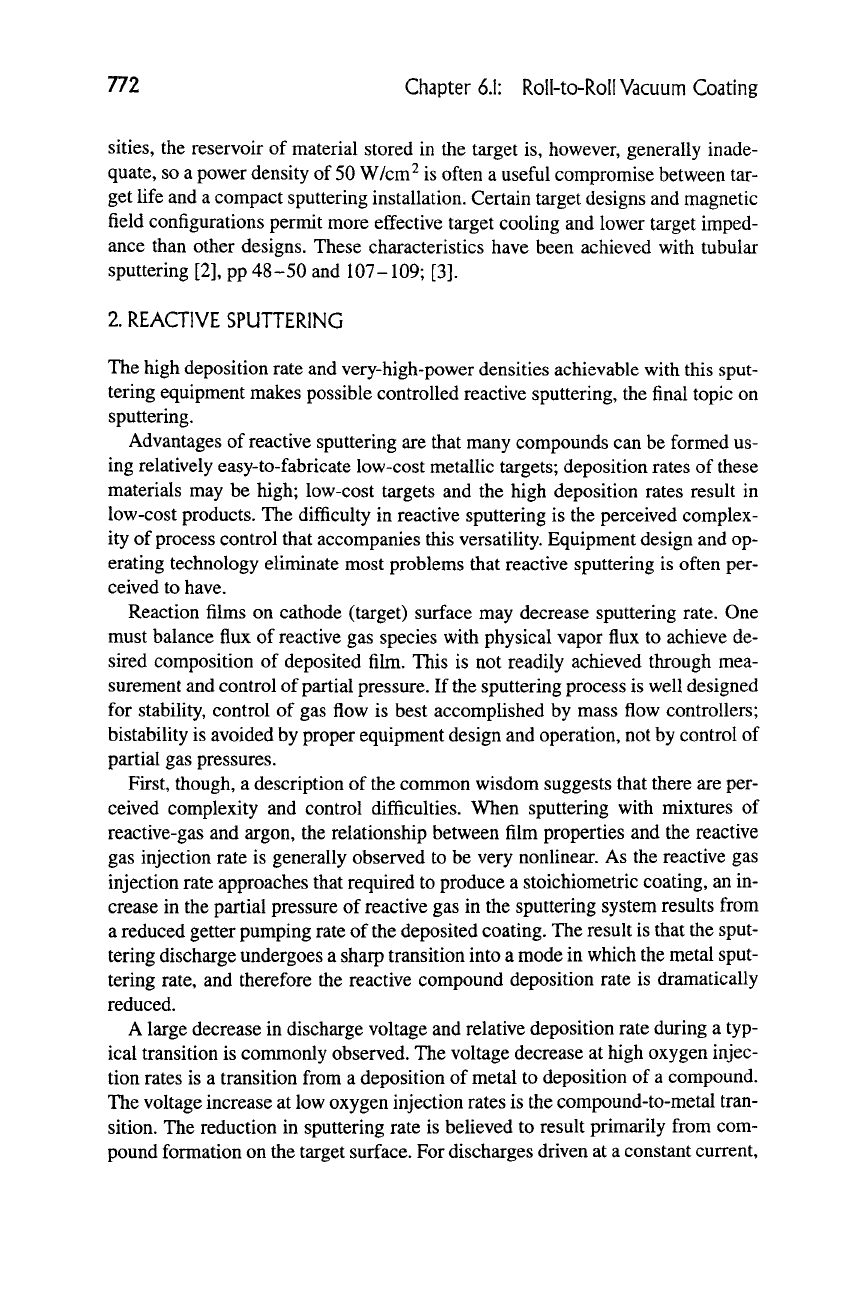
772 Chapter 6.1: RolI-to-RoII Vacuum Coating
sities,
the reservoir of material stored in the target is, however, generally inade-
quate, so a power density of 50 W/cm^ is often a useful compromise between tar-
get life and a compact sputtering installation. Certain target designs and magnetic
field configurations permit more effective target cooling and lower target imped-
ance than other designs. These characteristics have been achieved with tubular
sputtering [2], pp 48-50 and 107-109; [3].
2.
REACTIVE SPUTTERING
The high deposition rate and very-high-power densities achievable with this sput-
tering equipment makes possible controlled reactive sputtering, the final topic on
sputtering.
Advantages of reactive sputtering are that many compounds can be formed us-
ing relatively easy-to-fabricate low-cost metallic targets; deposition rates of these
materials may be high; low-cost targets and the high deposition rates result in
low-cost products. The difficulty in reactive sputtering is the perceived complex-
ity of process control that accompanies this versatility. Equipment design and op-
erating technology eliminate most problems that reactive sputtering is often per-
ceived to have.
Reaction films on cathode (target) surface may decrease sputtering rate. One
must balance flux of reactive gas species with physical vapor flux to achieve de-
sired composition of deposited film. This is not readily achieved through mea-
surement and control of partial pressure. If the sputtering process is well designed
for stability, control of gas flow is best accomplished by mass flow controllers;
bistability is avoided by proper equipment design and operation, not by control of
partial gas pressures.
First, though, a description of the common wisdom suggests that there are per-
ceived complexity and control difficulties. When sputtering with mixtures of
reactive-gas and argon, the relationship between film properties and the reactive
gas injection rate is generally observed to be very nonlinear. As the reactive gas
injection rate approaches that required to produce a stoichiometric coating, an in-
crease in the partial pressure of reactive gas in the sputtering system results from
a reduced getter pumping rate of the deposited coating. The result is that the sput-
tering discharge undergoes a sharp transition into a mode in which the metal sput-
tering rate, and therefore the reactive compound deposition rate is dramatically
reduced.
A large decrease in discharge voltage and relative deposition rate during a typ-
ical transition is commonly observed. The voltage decrease at high oxygen injec-
tion rates is a transition from a deposition of metal to deposition of a compound.
The voltage increase at low oxygen injection rates is the compound-to-metal tran-
sition. The reduction in sputtering rate is believed to result primarily from com-
pound formation on the target surface. For discharges driven at a constant current.
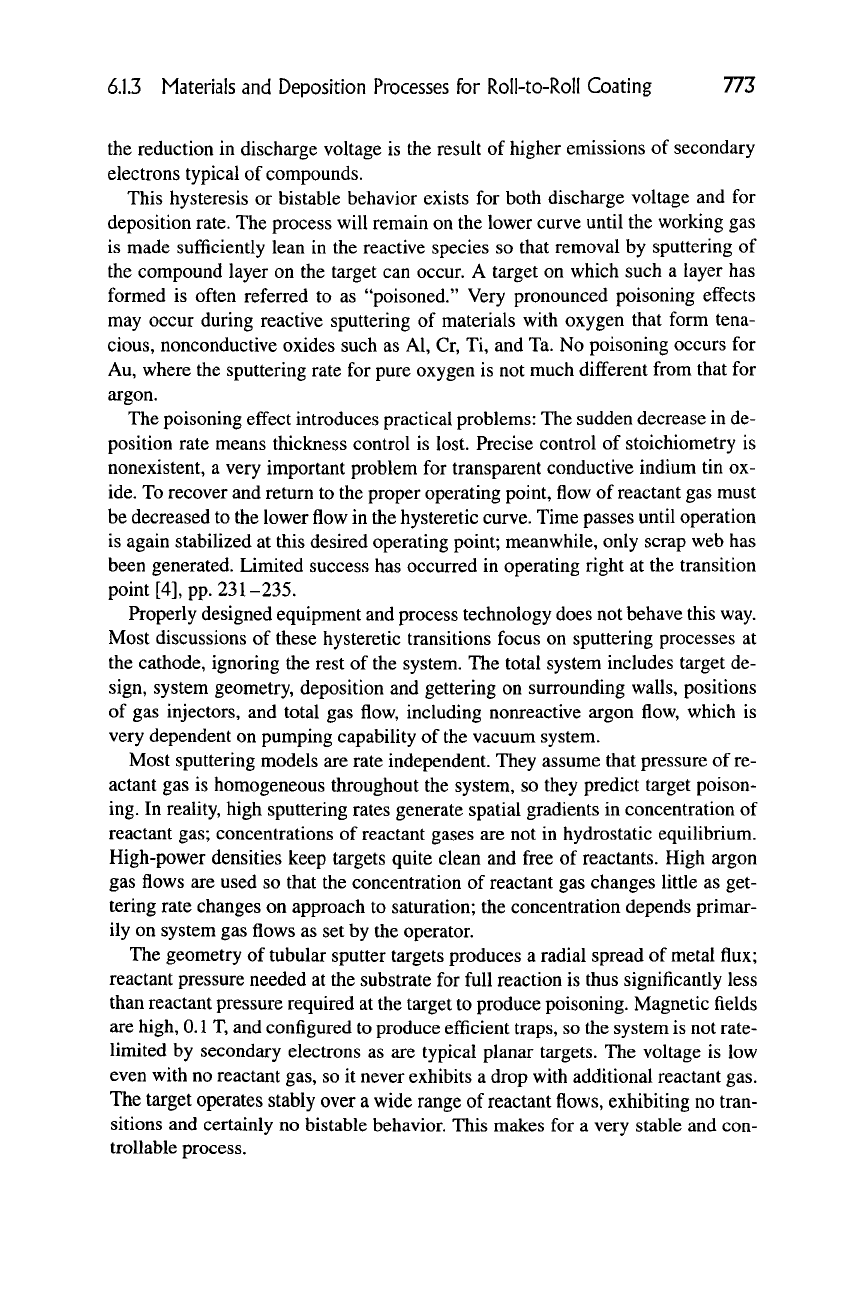
6.1.3 Materials and Deposition Processes for Roil-to-Roll Coating 773
the reduction in discharge voltage is the result of higher emissions of secondary
electrons typical of compounds.
This hysteresis or bistable behavior exists for both discharge voltage and for
deposition rate. The process will remain on the lower curve until the working gas
is made sufficiently lean in the reactive species so that removal by sputtering of
the compound layer on the target can occur. A target on which such a layer has
formed is often referred to as "poisoned." Very pronounced poisoning effects
may occur during reactive sputtering of materials with oxygen that form tena-
cious,
nonconductive oxides such as Al, Cr, Ti, and Ta. No poisoning occurs for
Au, where the sputtering rate for pure oxygen is not much different from that for
argon.
The poisoning effect introduces practical problems: The sudden decrease in de-
position rate means thickness control is lost. Precise control of stoichiometry is
nonexistent, a very important problem for transparent conductive indium tin ox-
ide.
To recover and return to the proper operating point, flow of reactant gas must
be decreased to the lower flow in the hysteretic curve. Time passes until operation
is again stabilized at this desired operating point; meanwhile, only scrap web has
been generated. Limited success has occurred in operating right at the transition
point[4],
pp. 231-235.
Properly designed equipment and process technology does not behave this way.
Most discussions of these hysteretic transitions focus on sputtering processes at
the cathode, ignoring the rest of the system. The total system includes target de-
sign, system geometry, deposition and gettering on surrounding walls, positions
of gas injectors, and total gas flow, including nonreactive argon flow, which is
very dependent on pumping capability of the vacuum system.
Most sputtering models are rate independent. They assume that pressure of re-
actant gas is homogeneous throughout the system, so they predict target poison-
ing. In reality, high sputtering rates generate spatial gradients in concentration of
reactant gas; concentrations of reactant gases are not in hydrostatic equilibrium.
High-power densities keep targets quite clean and free of reactants. High argon
gas flows are used so that the concentration of reactant gas changes little as get-
tering rate changes on approach to saturation; the concentration depends primar-
ily on system gas flows as set by the operator.
The geometry of tubular sputter targets produces a radial spread of metal flux;
reactant pressure needed at the substrate for full reaction is thus significantly less
than reactant pressure required at the target to produce poisoning. Magnetic fields
are high, 0.1 T, and configured to produce efficient traps, so the system is not rate-
limited by secondary electrons as are typical planar targets. The voltage is low
even with no reactant gas, so it never exhibits a drop with additional reactant gas.
The target operates stably over a wide range of reactant flows, exhibiting no tran-
sitions and certainly no bistable behavior. This makes for a very stable and con-
trollable process.

774 Chapter
6.1:
RolI-to-RoII
Vacuum
Coating
Gas mass flow meters for sputtering should be selected that have no zero drift
and good gain stability. Response speed, permitting rapid turn-on, important
for batch semiconductor processing, is not important for roll-to-roll deposition.
A slow response (30 sec) is acceptable, and this helps minimize overshoot on
turn-on.
Comments follow on selection of materials and alloys for sputtering:
• Materials used for roll-to-roll coating need not, in general, be as pure as
those used for semiconductor applications. Often only a few specific impuri-
ties arc of concern and need to be reduced. Generally, gas content of targets
needs to be minimized, especially oxygen, nitrogen, or hydrogen; oxygen in
copper is an example. Oxide inclusions and voids in metal and alloy targets
contribute to arcs, and thus need to be minimized.
• Generally, a commercially available alloy is used, options of composition
thus become limited.
• Material must have low permeability as received, typically in an annealed
state,
otherwise the magnetic field used to enhance sputtering will be shorted
by the target. "Ferromagnetism" [5] is useful for determining such magnetic
properties.
• After sputtering, the material should also be nonmagnetic. If it becomes mag-
netic,
for example, through a change of crystalline structure, then chips and
shards of sputtered material cling to targets, causing arcing. This is a prob-
lem observed on sputtering some types of stainless steel. Target fabrication
can represent a significant technical challenge for certain materials and target
designs, especially for targets used at high-power densities.
6.1.3.5 Cathodic Arc Deposition
Cathodic arc sources convert solid cathode material to plasma, vapor, and molten
droplets. The plasma has a higher concentration of ions than is typical in other
physical vapor deposition processes; these ions are often in multiple charge states
and have high kinetic energy. These ions permit external control of film morphol-
ogy and coating on non-line-of-sight surfaces. Easily achieved with this technol-
ogy are deposition of refractory metals and reactive deposition of refractory com-
pounds, producing materials that are hard and wear resistant. Molten droplets and
microdroplets emitted from these sources can be a serious limitation for many ap-
plications; much effort has been expended in reducing this problem. Useful cath-
ode materials must be electrically conducting and fully dense; operating with a
melted target reduces microdroplet emission. This technology has been applied
primarily in batch coating of tools and equipment, but has some utility in roll-to-
roll coating.
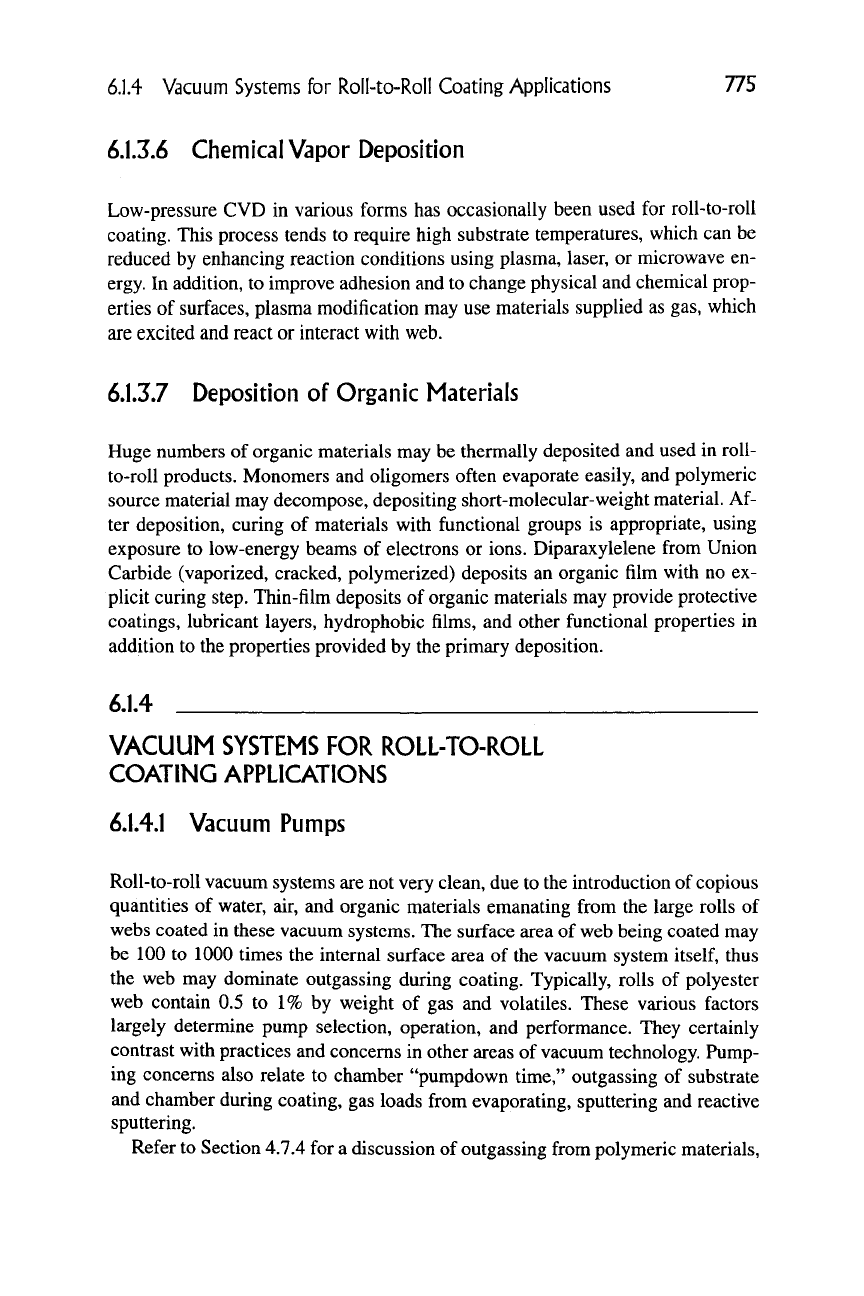
6.1.4 Vacuum Systems for RolI-to-RoIl Coating Applications 775
6.1.3.6 Chemical Vapor Deposition
Low-pressure CVD in various forms has occasionally been used for roll-to-roll
coating. This process tends to require high substrate temperatures, which can be
reduced by enhancing reaction conditions using plasma, laser, or microwave en-
ergy. In addition, to improve adhesion and to change physical and chemical prop-
erties of surfaces, plasma modification may use materials supplied as gas, which
are excited and react or interact with web.
6.1.3.7 Deposition of Organic Materials
Huge numbers of organic materials may be thermally deposited and used in roll-
to-roll products. Monomers and oligomers often evaporate easily, and polymeric
source material may decompose, depositing short-molecular-weight material. Af-
ter deposition, curing of materials with functional groups is appropriate, using
exposure to low-energy beams of electrons or ions. Diparaxylelene from Union
Carbide (vaporized, cracked, polymerized) deposits an organic film with no ex-
plicit curing step. Thin-film deposits of organic materials may provide protective
coatings, lubricant layers, hydrophobic films, and other functional properties in
addition to the properties provided by the primary deposition.
6.1.4
VACUUM SYSTEMS FOR ROLL-TO-ROLL
COATING APPLICATIONS
6.1.4.1 Vacuum Pumps
Roll-to-roll vacuum systems are not very clean, due to the introduction of copious
quantities of water, air, and organic materials emanating from the large rolls of
webs coated in these vacuum systems. The surface area of web being coated may
be 100 to 1000 times the internal surface area of the vacuum system
itself,
thus
the web may dominate outgassing during coating. Typically, rolls of polyester
web contain 0.5 to 1% by weight of gas and volatiles. These various factors
largely determine pump selection, operation, and performance. They certainly
contrast with practices and concerns in other areas of vacuum technology. Pump-
ing concerns also relate to chamber "pumpdown time," outgassing of substrate
and chamber during coating, gas loads from evaporating, sputtering and reactive
sputtering.
Refer to Section 4.7.4 for a discussion of outgassing from polymeric materials.
